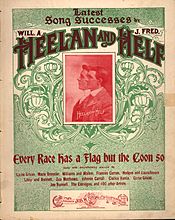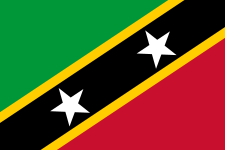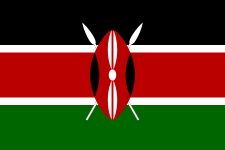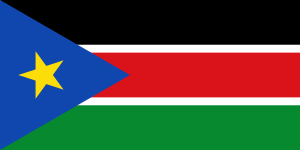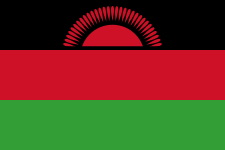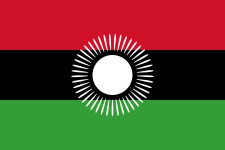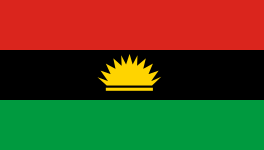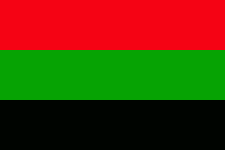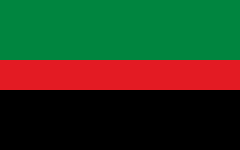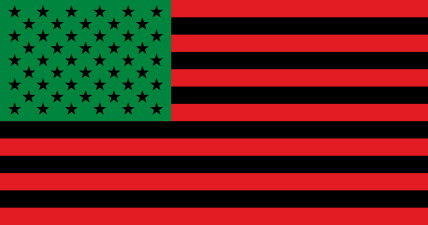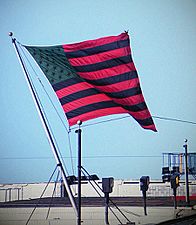Pan-African flag facts for kids
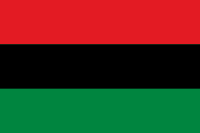 |
|
| Name | Pan-African Flag Various other names |
|---|---|
| Adopted | 13 August 1920 |
| Design | A horizontal triband of red, black, and green. |
| Designed by | Marcus Garvey |
The Pan-African flag is a special flag with three equal horizontal stripes: red, black, and green. It's also known by names like the Afro-American flag or Black Liberation flag.
This flag was officially adopted on August 13, 1920. It was chosen by the Universal Negro Improvement Association and African Communities League (UNIA-ACL). This happened during a big meeting in New York City. Different versions of this flag are used in many places to show support for Garveyism, which is a movement focused on Black pride and unity.
Contents
History of the Pan-African Flag
The Pan-African flag was created in 1920. It was made by members of the UNIA. They wanted to respond to a popular song from the late 1800s. This song was very disrespectful to African Americans. It made fun of them and their way of speaking.
In 1927, Marcus Garvey, a leader of the UNIA, spoke about the flag. He said, "Show me the race or the nation without a flag, and I will show you a race of people without any pride." He explained that people used to say, "Every race has a flag but the coon" (referring to the disrespectful song). But he added, "They can't say it now." This meant that Black people now had their own flag to be proud of.
What the Colors Mean
The UNIA explained the meaning of the flag's colors in 1921.
- Red stands for the blood that people must shed for their freedom.
- Black represents the noble and important race of Black people.
- Green symbolizes the rich plant life of Africa, their Motherland.
More recently, the UNIA has shared a slightly different meaning for the colors:
- Red: The blood that connects all people of Black African heritage. It also stands for the blood shed for freedom.
- Black: Black people themselves. The flag shows that they exist as a nation, even without their own country.
- Green: The rich natural resources and wealth of Africa.
A Symbol of Black Pride
The Pan-African flag became a strong symbol for Black people's freedom around the world. It became very popular in the 1960s during the Black Liberation movement. This was a time when many people fought for equal rights.
In 1971, a school board in Newark, New Jersey, decided to allow the flag in public school classrooms. This caused a lot of discussion and debate. Some people supported it as a symbol of pride. Others questioned if it should be in schools.
The Flag Today
In the United States, you can easily find the Pan-African flag in stores. It is often seen at events like Martin Luther King Jr. Day parades. It also appears at civil rights rallies and other special gatherings. It continues to be a symbol of Black pride and unity.
Juneteenth and the Flag
Many African Americans use the Pan-African flag to represent Juneteenth. Juneteenth is a holiday celebrating the end of slavery in the United States. While Juneteenth has its own flag, the Pan-African flag is also often used during this celebration.
Recent Uses of the Flag
In 2014, after a grand jury decision in Ferguson, Missouri, a student at Howard University replaced the U.S. flag on a flagpole with the Pan-African flag. The flag was flown at half-mast. This was done as a symbol of "black solidarity" and protest.
Flags Inspired by the Pan-African Flag
The Pan-African flag has inspired many other flags around the world.
-
Flag of Saint Kitts and Nevis
-
Flag of Kenya
-
Flag of South Sudan
-
Flag of Malawi
-
Proposed flag for Angola (1996)
National Flags
Several countries in Africa and the Caribbean have flags inspired by the UNIA flag.
- The Flag of Biafra (used from 1967-1970) is a version of the UNIA flag. It has a sun in the middle. Its colors are directly based on Marcus Garvey's design.
- The flag of Malawi (from 1964) looks very similar. Its colors have the same meaning: red for struggle, green for plants, and black for the people.
- The Kenyan flag was adopted in 1963 when Kenya became independent. It has black, red, and green stripes with white lines. It also features a Masai shield and spears. It was inspired by the Pan-African colors.
- The flag of Saint Kitts and Nevis also uses similar colors. They are arranged diagonally with yellow lines. Like Malawi's flag, its colors have the same meaning as the Pan-African flag.
Flags in the United States
-
Flag of the Republic of New Afrika
Some flags in the United States have also been inspired by the Pan-African flag. For example, a company called NuSouth created a flag similar to the Confederate flag. But they changed the colors to green, black, and red to represent African Americans.
The Kwanzaa Bendera
In the 1960s, an organization called Us redesigned the UNIA flag. They changed the order and meaning of the colors slightly. They defined black for the people, red for struggle, and green for the future that comes from struggle.
In 1997, the United States Postal Service released a stamp for Kwanzaa. Kwanzaa is an African-American festival. The stamp showed a family holding a flag. This flag was meant to represent the Pan-African flag. However, it actually showed the flag of the Us Organization, which is similar. This flag is called the bendera (which means flag in Kiswahili). It is used as a symbol during the Kwanzaa festival.
Artworks
In 1990, artist David Hammons created an artwork called African-American Flag. It is now in the Museum of Modern Art in New York City. This artwork looks like the U.S. flag. But its stripes are black and red, and the blue part is green. The stars on it are black.
-
African American Flag in New York city
Alternative Names
The Pan-African flag is known by several other names:
- The Afro-American flag
- The Bendera Ya Taifa (Kiswahili for "flag of the Nation"), used during Kwanzaa
- The Black Liberation flag
- The International African flag
- The Marcus Garvey flag
- The UNIA flag, named after the group that created it
- The Universal African flag
- The Red Black Green (RBG) flag
- The Black Nationalist flag
Proposed Holiday
In 1999, an idea was suggested to celebrate August 17 as Universal African Flag Day. This day would be a global celebration of the red, black, and green flag. August 17 is the birthday of Marcus Garvey, who was a key figure in the flag's creation.
See also
 In Spanish: Bandera panafricana para niños
In Spanish: Bandera panafricana para niños


